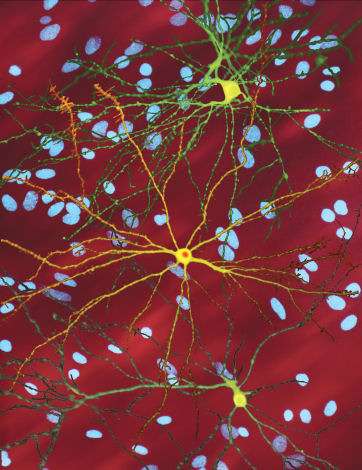Researchers find important new piece in the Huntington's disease puzzle

In a new study, researchers from the University of Copenhagen have discovered a hitherto unknown error in the transport of glutamine between astrocytes and neurons in the brain of mice with Huntington's disease. At the same time, it is a relevant area on which to focus the effort of developing a future treatment for the disease, the researchers believe.
There is currently no cure for the hereditary brain disorder Huntington's disease, which causes personality alterations and loss of motor control. But now researchers have come one step closer to uncovering what actually happens in the brain of Huntington's patients. In a new study, researchers from the Novo Nordisk Foundation Center for Protein Research and the Department of Drug Design and Pharmacology at the University of Copenhagen have discovered a hitherto unknown error in the transport of glutamine in the brain of mice suffering from Huntington's disease.
The study, which has been published in the scientific journal Cell Reports, describes how an important exchange between astrocytes and neurons in the brain is disturbed during Huntington's disease—more precisely, the glutamate-GABA-glutamine cycle. According to the researchers, this highlights the important role of astrocytes in the brain.
"Researchers used to believe that hereditary diseases—including Huntington's disease—were primarily a result of problems in the neurons. But here, we show and confirm that the astrocytes also play a main role. Glutamine is produced in the astrocytes and transported to the neurons, where it is used to make neurotransmitters. They are central to the ability to send signals across the brain. If the transport of glutamine from the astrocytes is lost, the neurons stop functioning optimally," says co-author Niels Henning Skotte.
The researchers analysed the protein alterations seen in the four regions of the brain—the striatum, cortex, hippocampus and diencephalon—in mice with advanced Huntington's disease compared to healthy mice. They found that the striatum, as in humans, was more affected than the other regions of the brain. They found a total of around 900 protein alterations. This was supported by the researchers' metabolic studies, which also showed a majority of disorders in the striatum.
The most important find of the study, according to the researchers, is the reduced exchange of glutamine between astrocytes and neurons. And it is a research area with potential when it comes to future research into whether a normal release of glutamine from the astrocytes can potentially alleviate the symptoms of Huntington's disease.
"Even though Huntington's disease is a genetic disease, our study shows a dysregulation of the proteins and the signalling pathways of these proteins. There is currently no cure for Huntington's disease. But if we were able to find areas in which the effects of the disease may potentially be improved or reduced, it would be a big step in the right direction. This study may provide suggestions for focus areas of future research," says Professor Michael Lund Nielsen.
More research is required to clarify the role played by dysregulated glutamine transport in the development of Huntington's disease. However, data suggests that the cycle is disturbed early in the course of the disease. If this proves correct, it may perhaps play an even greater role in the development of the disease, just as it may potentially increase the chances of alleviating the symptoms, the authors of the study say.
More information: Niels H. Skotte et al, Integrative Characterization of the R6/2 Mouse Model of Huntington's Disease Reveals Dysfunctional Astrocyte Metabolism, Cell Reports (2018). DOI: 10.1016/j.celrep.2018.04.052


















